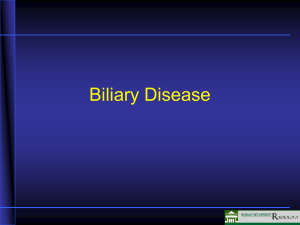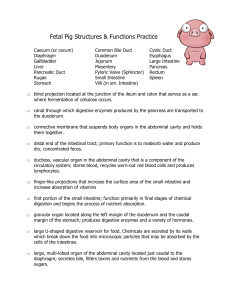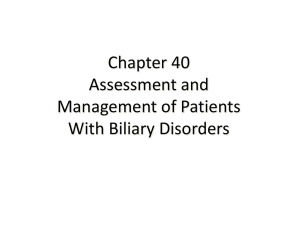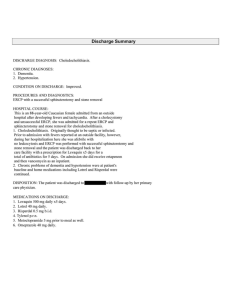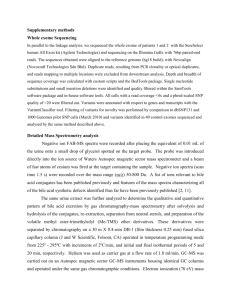The Biliary System
advertisement
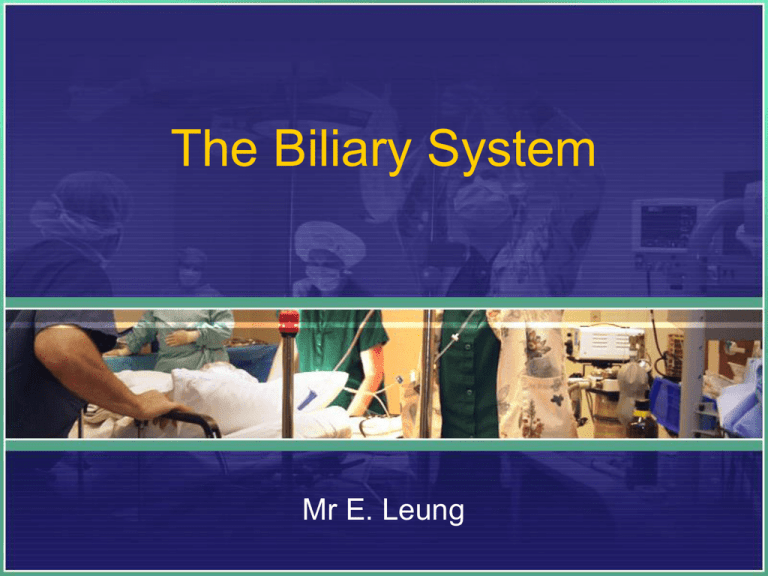
The Biliary System Mr E. Leung Content • Surgical Anatomy • Physiology • Investigations for biliary tree • Common Pathology SURGICAL ANATOMY Surgical Anatomy - Gallbladder • Pear shaped • 7 – 13 cm in length, Volume ~ 50ml • Cystic duct 1 – 3cm – Spiral valves of Heister • Fundus, body, neck and Hartmann’s pouch Surgical Anatomy - Gallbladder • Lies between quadrate lobe and right lobes • Covered in peritoneum except the GB fossa Surgical Anatomy - Gallbladder • 1st + 2nd part of duodenum lies behind • T-colon lies inferiorly • Common Bile Duct (CBD) – 7cm long – 7mm wide – pressure of 7mmHg Surgical Anatomy – Calots Triangle Surgical Anatomy – Common Bile Duct • CBD = CHD + cystic duct – Supraduodenal part – • free edge of lesser sac • 2.5cm long – Retroduodenal part – Infraduodenal part – Intraduodenal part Surgical Anatomy – Major and minor papilla • CBD enters duodenum posteromedially • Joins pancreatic duct = Ampulla of Vater – (10cm from pylorus) • Accessory pancreatic duct joins duodenum via minor papilla Endoscopic view of Ampulla of Vater, also known as Major duodenal papilla Surgical Anatomy – Sphincter of Oddi • Circular muscle of duodenum wraps around the confluence of the pancreatic duct and CBD • Forms a sphincter and prevents reflux of duodenal contents Surgical Anatomy – nerve supply • T7-9 sympathetic and parasympathetic vagus • Afferent fibres (including pain) => coeliac plexus => greater splanchnic nerves => dorsal ganglia • Preganglionic efferent fibres => coeliac plexus => postganglionic fibres run along the hepatic artery • Vagus stimulation = GB to contract, Oddi to relax PHYSIOLOGY Physiology – Bile salts • Bile = 97% water, 2% bile salts, 1% pigments • Bile acids are synthesised in the liver from cholesterol • Primary bile acids = chenodeoxycholic + cholic acid – Conjugated with Taurine + Glycine = water soluble bile salts • Secondary bile salts = gut bacterial metabolism (deoxycholic and lithocholic acid) Physiology – function of gallbladder + bile • Concentrates and stores bile (upto 10x) • Mucin secretion • Bile + small globlets of fat = micelles • Allows digestion by lipases Physiology – The enterohepatic circulation • Secretin and CCK, secreted by duodenum • low pH or high fat content • CCK => GB to contract and Oddi to relax • Secretin => bile production and pancreatic juice release CLINICAL INVESTIGATIONS Investigations • Largely radiological • Blood tests: – inflammatory markers, GGT, LFTs, Clotting, Amylase • Radiology: – AXR, USS, cholangiography (oral, iv or intraductal) – CT, MRCP, radionuclide scans (HIDA or PIPIDA) Radiological investigations • Plain AXR • USS Radiological investigations • Cholangiography • CT – better at assessing the pancreas • MRCP – best resolution in assessing the biliary tree • Tc-labelled scan – functional study PATHOLOGY Congenital abnormalities • Atresia – type I, II and III or Gallbladder – 1 in 30,000 • Double or intra-hepatic gallbladder • Phrygian cap • Choledochal cysts Acquired pathology – Gallstone disease • Very common – The 4 “F”s – F:M = 3:1 West > East 1. Pure cholesterol stone – 5% 2. Mixed stone (70%) – Lecithin, cholesterol and salts 3. Pure pigment stones – 25% • 90% of time is radiolucent Causes of Gallstone formation • Changes in bile composition, multifactorial – Supersaturation – Precipitation 1. Metabolic – e.g. diet, cirrhosis 2. Infective – e.g. reflux of bile 3. Biliary stagnation – e.g. pregnancy Complications of gallstones Complications of gallstones • Biliary colic – Analgesia then cholecystectomy • Cholecystitis • Mucoceole • Perforation Cholangitis Abx and ERCP, then cholecystectomy – Abx then cholecystectomy • GS ileus – Surgery Pancreatitis Other benign gallbladder conditions • Strawberry GB – lipid/cholesterol infiltration to mucosa • Adenomyomatosis - Mucosal diverticula • Acalculus cholecystitis – 5% – Precipitated by illness, surgery or trauma • Benign polyp Symptoms of gallstone disease Most gallstones are asymptomatic Symptoms of gallstone disease • Biliary colic – Intermittent colicky RUQ pain – Post-prandial vomiting – Right shoulder pain • Cholecystitis – Constant sharp RUQ pain – Fever and vomiting (not post-prandial) Symptoms of gallstone disease • Cholangitis – Jaundiced (urine, faeces, itch) – Rigors – Colicky RUQ pain • Pancreatitis – Continuous sharp pain alleviated by leaning forward – Other symptoms for complications of pancreatitis… Differential diagnoses • PUD / Gastritis / GORD • Pancreatitis • Liver pathology • Cardiac ANY QUESTIONS

